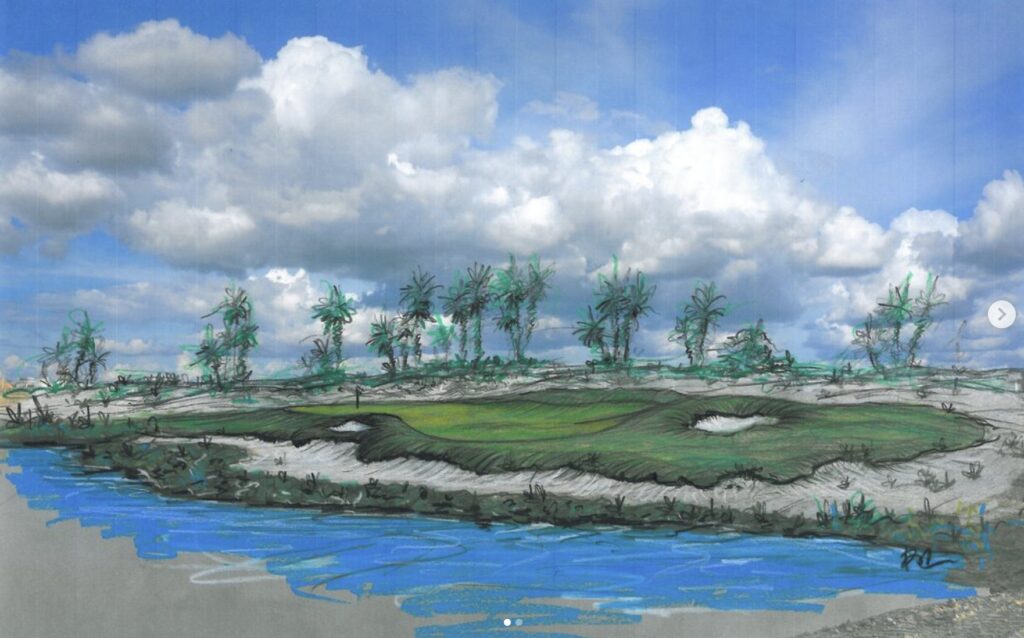John Pagano, Group CEO of Red Sea Global, a Saudi government-funded development set to open on the west coast of Saudi Arabia that includes an 18-hole golf course called Shura Links, discusses the need for the golf industry to continue its transition towards adopting more sustainable practices when it comes to golf course development and maintenance
Golf is a sport cherished for its rich tradition and community-building potential, offering health benefits and a unique connection to nature. It is also rapidly growing. According to industry body R&A, the sport has gained 10 million players since 2016, driving the total number of on-course golfers to 39.6 million across R&A-affiliated markets. Despite this growth, golf faces critical environmental challenges that demand innovative solutions.
Golf courses have traditionally been seen as expansive and meticulously maintained green spaces that consume considerable amounts of water and land, often in areas where these resources are scarce. The sport also faces criticism for its use of chemicals and energy, contributing to a public perception that it may not align with modern environmental values.
As industry leaders, we must address these challenges by integrating sustainability into every aspect of golf course design, development, and management, demonstrating that enjoying the sport while preserving our planet for future generations is possible.
The sport has witnessed a remarkable popularity surge in recent years, with countries beyond traditional stalwarts, the US and Europe, seeing a marked lift in interest and participation.
This has been partly driven by strategic initiatives to make the sport more accessible, such as those by Saudi Arabia’s Public Investment Fund, which is focused on transforming golf into a more inclusive and engaging sport for players at all levels. This boom has brought a new wave of enthusiasts and a renewed focus on making the sport more inclusive and diverse.
Sustainable Practices
As the global golf community expands, the focus on sustainable practices becomes even more critical and is emerging as a cornerstone of design and operation. The industry has introduced cutting-edge solutions, such as using drought-resistant grasses, efficient irrigation systems, and high-tech devices such as soil sensors and drones to optimize water management and maintain healthy turf.
Courses are increasingly adopting water-efficient irrigation systems, such as those seen at the famous Pebble Beach Golf Links course in California, which uses recycled water for irrigation to significantly reduce freshwater consumption.
The use of native plant species is another trend gaining momentum. For example, the US-based Audubon Cooperative Sanctuary Program for Golf promotes native landscaping that supports local wildlife and reduces the need for pesticides and fertilizers.
Designing layouts that preserve natural habitats is also critical. For instance, the Streamsong Resort in Florida has been designed to blend into its natural surroundings, preserving the existing fauna and flora while minimizing land disturbance. These practices are becoming standard, driven by environmental necessity and consumer demand for more responsible recreation.
Technological Advancements
Technological advances are important in the shift toward sustainable golf practices. GPS devices and mobile apps are now commonly used to enhance golf course management by optimizing maintenance routines and resource use. For example, the Toro Company offers GPS-guided sprayers that apply chemicals only where needed, greatly reducing the quantity used and minimizing runoff into the environment.
Similarly, mobile apps like the Rain Bird app allow course superintendents to control irrigation systems remotely, adjusting watering schedules based on real-time weather data to avoid overwatering. Cloud-based management systems further enable courses to integrate data across various operations, improving efficiency and reducing waste.

Putting Policies First
Beyond technology, the golf industry has also taken great strides toward improving policies for sustainable design and management. The Environmental Principles for Golf Courses in the United States offers comprehensive strategies for sustainable management, focusing on water conservation, chemical use reduction, and wildlife habitat preservation. Similarly, the Golf Environment Organization (GEO) is a non-profit organization dedicated to advancing sustainability within the golf industry.
GEO’s Guidelines for Sustainable Golf Development provide a robust framework for new projects. They emphasize the integration of courses within their natural landscapes and the minimization of environmental impact through thoughtful site selection and sustainable construction practices. These guidelines are instrumental in shaping golf courses that respect and enhance the environment.
Transitioning from policy formation to implementation, the Sustainable Golf Renovations Guidelines spotlight the critical area of course upgrades. This document encourages existing facilities to adopt sustainable practices, such as retrofitting irrigation systems for better water management and employing native vegetation to reduce maintenance needs and support local biodiversity.

Innovative Practices at Shura Links
At Red Sea Global, we recently announced the designs and plans for our championship golf course, Shura Links, Saudi Arabia’s first 18-hole island golf course. Designed by the renowned Schmidt-Curley Design, it aims to set new standards in golf course sustainability, including being powered 100% by renewable energy. Curley’s design minimizes environmental impact while delivering a world-class golfing experience.
Key to our approach is significantly reducing water use, a critical concern in arid regions, and using recycled water. By carefully selecting turfgrass that requires less water and employing soil sensors, we ensure efficient moisture management, drastically cutting down water waste. This system is complemented by an innovative irrigation strategy that serves the course and supports nearby mangrove forests, helping accelerate their growth and sustain local biodiversity.
Furthermore, Shura Links adopts a zero-herbicide policy. We employ foliar feeding techniques that maximize nutrient uptake and enhance the health and resilience of the turf while preventing runoff. By minimizing maintained turf areas – only 20% of the 140-hectare site – and using irregular turf lines and transitional bunkering, the course mimics the surrounding dunescapes. This design philosophy reduces the environmental footprint and enhances the visual and playing experience, offering each golfer a unique connection to the natural world.
By adhering to and exceeding the standards set by GEO, we ensure that Shura Links sets a precedent for future developments worldwide. Our partnership with Golf Saudi further enhances our ability to maintain these standards, ensuring that every aspect of Shura Links aligns with our overarching vision for sustainability and luxury.
As we look forward to opening Shura Links next year, we see the future of golf striking a balance between enhancing the sport’s accessibility and mitigating its environmental impact. We’re going the extra mile to ensure that whatever we do is done with regeneration at its core. We must go above and beyond to enhance the environments we develop, whether for luxury tourism resorts or spectacular golf courses. We invite the global community to join us in this exciting journey towards a greener, more inclusive golfing landscape.

